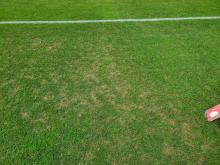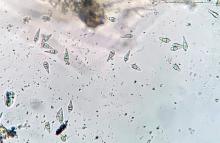Hosts Perennial ryegrass as well as annual ryegrass and tall fescue.
Cause Pyricularia oryzae, a fungus that is favored by climates with hot, humid summers which typically do not occur in western Oregon. However, the disease was been found when an extreme heat and humidity event took place. Athletic field turf can exhibit aggregated patches of blighted leaves and dieback. Newly emerging seedlings are most susceptible to gray leaf spot and the disease is more severe at higher cutting heights.
Symptoms The disease typically begins as small, water-soaked lesions on leaf blades that develop into dark, necrotic spots. Leaf spots were oval to diamond-shaped with defined edges and discolored centers. These spots expand to become circular to oblong lesions and become gray to grayish-brown with dark brown to reddish-brown borders. Lesions coalesce and cause tip blighting, which often leads to twisting or flagging of leaf blades. Diseased turfgrass stands exhibit diffuse blighting symptoms and have a dull or wilted appearance. Affected turf will ultimately collapse and appear as sunken, irregularly shaped patches.
Cultural control Cultural practices alone will not control this disease and must be combined with fungicide management.
- Plant resistant cultivars that have been shown to do well in the Pacific Northwest.
- Mow 1.5 to 2 inches tall and remove clippings.
- Remove excess thatch in early spring and aerify if needed to provide good aerification and drainage.
- Avoid excessive nitrogen fertilization during the late spring or summer months, no more than 0.5 lb N/1,000 sq ft.
- Time irrigations to minimize leaf wetness periods.
- Time irrigations to minimize leaf wetness periods.
- Delay seedings until temperatures are less conducive for disease development
Chemical control To prevent developing resistant fungi, alternate or tank-mix materials from different groups with different modes of action.
- Compass at 0.1 to 0.25 oz/1,000 sq ft. Do not use organosilicate additives. Group 11 fungicide. 12-hr reentry.
- Daconil Weather Stik at 2 to 3.6 fl oz/1,000 sq ft. Group M5 fungicide. 12-hr reentry.
- Eagle 20 EW at 1.2 to 2.4 fl oz/1,000 sq ft. Low efficacy when used alone. Group 3 fungicide. 24-hr reentry.
- Fame SC at 0.2 to 0.4 fl oz/1,000 sq ft. Group 11 fungicide. 12-hr reentry.
- Floxcor at 0.18 to 0.36 fl oz/1,000 sq ft plus an adjuvant. Group 11 fungicide. 12-hr reentry.
- Heritage at 0.4 oz/1,000 sq ft. 4-hr reentry.
- Insignia SC at 0.4 to 0.7 fl oz/1,000 sq ft. Do not use with organosilicate adjuvants. Group 11 fungicide. 12-hr reentry.
- Mancozeb 80% (Fore, Manzate, and Protect DF) at 8 oz/1,000 sq ft. Moderate efficacy, best as a preventative application. Group M3 fungicide. 24-hr reentry.
- Medallion SC at 1 to 2 fl oz/1,000 sq ft. Apply after mowing. Using with oils or adjuvants may damage plant. Limited published data on efficacy. Group 12 fungicide. 12-hr reentry.
- Propiconazole-based products. Group 3 fungicides.
- Banner MAXX at 1 to 2 fl oz/1,000 sq ft. 12-hr reentry.
- PropiMax EC at 0.37 to 0.73 fl oz/1,000 sq ft. 12-hr reentry.
Combination Fungicides
- Armada 50 WDG at 0.6 to 1.5 oz/1,000 sq ft. Do not use a silicone-based surfactant. Limited published data on efficacy. Group 3 + 11 fungicide. 12-hr reentry.
- Briskway at 0.5 to 1.2 fl oz/1,000 sq ft. Can be used in hot weather. Group 3 + 11 fungicide. Limited published data on efficacy. Reentry when sprays have dried.
- Concert at 3 to 8.3 fl oz/1,000 sq ft. Do not use on fine fescue turf. Group 3 + M5 fungicide. 12-hr reentry.
- Encartis at 3 to 4 fl oz/1,000 sq ft. Do not use with oil-based pesticides. Limited published data on efficacy. Group 7 + M5 fungicide. Reentry when sprays have dried.
- Headway at 1.5 to 3 fl oz/1,000 sq ft. Do not use with silicone-based surfactants or EC formulations. Group 3 + 11 fungicide. 12-hr reentry.
- Heritage Action at 0.2 to 0.4 oz/1,000 sq ft. Group 11 + P1 fungicide. 12-hr reentry.
- Honor at 0.55 to 1.1 oz/1,000 sq ft. Do not use with organosilicone-based adjuvants. Group 7 + 11 fungicide. Golf course turf only.
- Lexicon at 0.34 to 0.47 fl oz/1,000 sq ft. Limited published data on efficacy. Group 7 + 11 fungicide. 12-hr reentry.
- Navicon at 0.7 to 0.85 fl oz/1,000 sq ft. Group 3 + 11 fungicide. 12-hr reentry.
- Pillar SC at 1 fl oz/1,000 sq ft. Group 3 + 11 fungicide. 12-hr reentry.
- Renown at 2.5 to 4.5 fl oz/1,000 sq ft. Group M5 + 11 fungicide. 12-hr reentry.
- Tartan at 1 to 2 fl oz/1,000 sq ft. Limited published data on efficacy. Group 3 + 11 fungicide. 12-hr reentry.
Reference Braithwaite, E., Wang, R., Kowalewski, A., Tabima, J. F., Temple, T. N. and Rivedal, H. M., 2023. First Report of Pyricularia oryzae Causing Gray Leaf Spot of Perennial Ryegrass (Lolium perenne) in Oregon. Plant Health Progress, 24:382-385.
Vines, P. L., Daddio, R. M., Luo, J., Wang, R., Murphy, J. A., Zhang, N., Clarke, B. B., Meyer, W. A. and Bonos, S. A., 2022. Pyricularia oryzae incites gray leaf spot disease on hard fescue (Festuca brevipila). International Turfgrass Society Research Journal, 14:997-1002.




